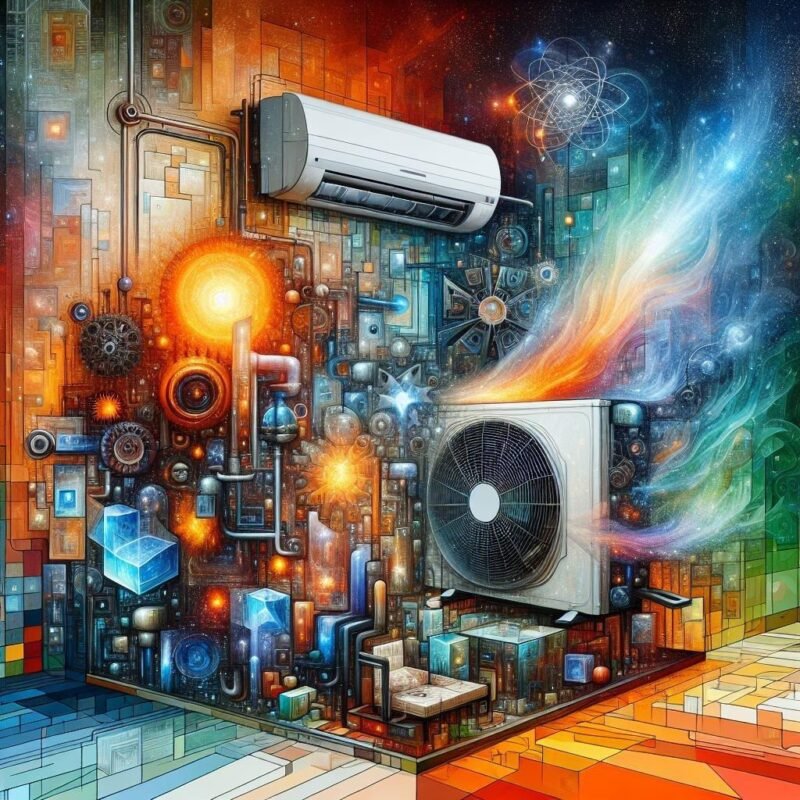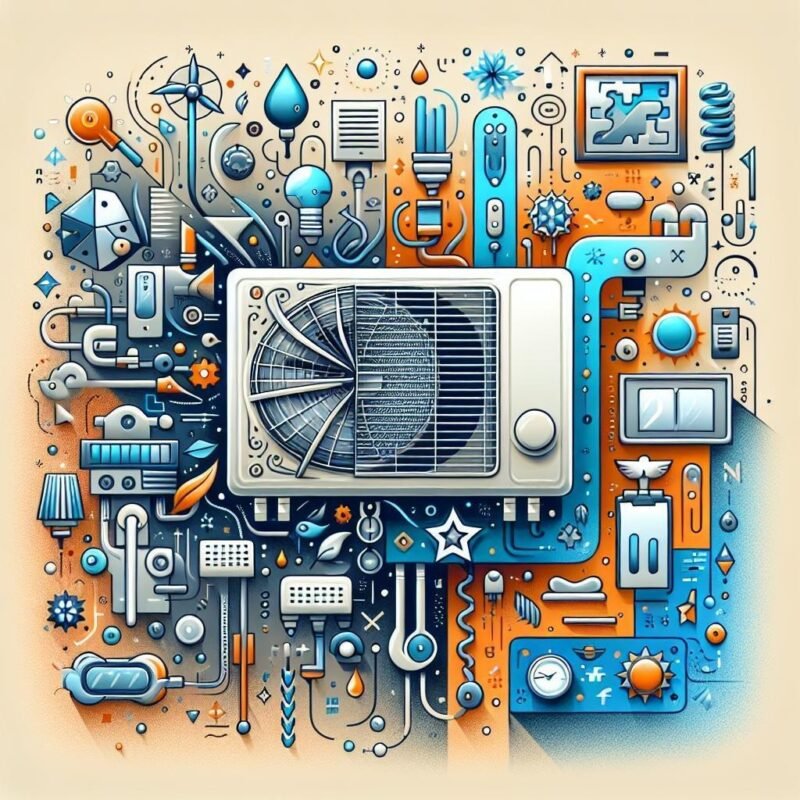What types of filters are used in a mini split AC system?

Ever wondered what’s keeping yoru mini split AC running smoothly and your air pristine? Those mysterious filters tucked away inside your system are the unsung heroes of clean, comfortable air. Just like a bouncer at an exclusive club, these filters work tirelessly to keep unwanted particles out while letting the good stuff flow freely. From basic pre-filters to fancy carbon-activated ones, there’s a whole team of filtration champions working behind the scenes of your mini split system. Let’s dive into the fascinating world of mini split AC filters and discover how these little warriors keep your indoor air fresh and clean.
Essential Filters That Keep Your Mini Split Running Smoothly
Mini-split systems rely on multiple layers of filtration to maintain peak performance and deliver clean,comfortable air throughout your space. the pre-filter acts as the first line of defense, capturing larger particles like dust, pet hair, and lint before they can reach deeper into the system. Behind this initial barrier, you’ll find specialized filters that target specific contaminants: activated carbon filters absorb unwanted odors and harmful gases, while electrostatic filters use an electrical charge to attract and trap microscopic particles that might otherwise slip through.
Regular maintenance of these crucial components ensures your mini-split operates at its best while promoting healthier indoor air quality. Here’s what you need to keep an eye on:
- Washable mesh filters (clean monthly)
- Plasma ion filters (check quarterly)
- Photocatalytic filters (replace annually)
- HEPA filters (change every 2-3 years)
| Filter Type | Particle Size Captured |
|---|---|
| Pre-filter | 10+ microns |
| HEPA | 0.3 microns |
| Carbon | Gas molecules |
The Battle Against Airborne Enemies: Understanding Pre-Filters and HEPA Filtration
When it comes to defending your indoor air quality, pre-filters act as the first line of defense in your mini split system. These unsung heroes capture larger particles like dust, pet hair, and pesky pollen before they can reach deeper into the system. Think of them as bouncers at an exclusive club,keeping unwanted guests from crashing your clean air party. By trapping these bigger particles, pre-filters not only protect your indoor environment but also extend the life of the more sophisticated filters that follow.
The real star of the show is the HEPA filtration system, wich takes air purification to the next level by capturing microscopic particles as small as 0.3 microns. these mighty filters can trap up to 99.97% of airborne contaminants, including:
- Bacteria and microorganisms
- Smoke particles
- Fine dust mites
- Microscopic allergens
| Filter Type | Particle Size Trapped | Efficiency Rate |
|---|---|---|
| Pre-filter | 10+ microns | 80-85% |
| HEPA | 0.3 microns | 99.97% |
Beyond Basic Filtering: Activated Carbon and Photocatalytic Technology
Enhancing the filtration capabilities of your mini split system goes far beyond standard mesh filters. Activated carbon technology works like a molecular sponge, trapping harmful gases, volatile organic compounds (VOCs), and unwanted odors through a process called adsorption. These specialized filters contain millions of microscopic pores that create an enormous surface area – just one gram of activated carbon has a surface area equivalent to several tennis courts! This remarkable material doesn’t just mask odors; it physically captures and holds onto molecular-sized pollutants,making your indoor air genuinely cleaner and fresher.
Taking air purification to the next level,photocatalytic technology harnesses the power of light to destroy contaminants rather than simply trapping them. when UV light hits the special titanium dioxide coating on these filters, it triggers a chemical reaction that breaks down harmful substances into harmless compounds. This advanced filtration method effectively tackles:
- Bacteria and viruses
- Chemical fumes and gases
- Stubborn pet odors
- Mold spores and allergens
- Tobacco smoke residue
| Filter Type | Particle Removal Rate | Odor Control |
|---|---|---|
| Activated Carbon | 95% | Excellent |
| Photocatalytic | 99% | Superior |
Smart Filter Solutions: When to Clean, Replace, and Upgrade Your Mini Split protection
Maintaining pristine filter performance requires a well-planned maintenance schedule that aligns wiht your specific usage patterns.Standard mesh filters typically need monthly cleaning during peak cooling seasons, while premium antimicrobial filters can extend their cleaning intervals up to 6-8 weeks. Watch for telltale signs like reduced airflow,unusual sounds,or visible dust accumulation – these are your system’s way of requesting immediate attention. Many homeowners mark their calendars for the first Sunday of each month as their filter maintenance day, making it a simple part of their routine.
Knowing when to make the leap from cleaning to replacing or upgrading your filters can substantially impact your indoor air quality. Here’s what you need to consider:
- Replace basic filters annually, even with regular cleaning
- Upgrade to high-MERV filters if you have pets or allergies
- Consider plasma filters for maximum air purification
- Install washable filters to reduce environmental impact
| Filter Type | Cleaning Frequency | Replacement Timeline |
|---|---|---|
| Standard Mesh | monthly | 12 months |
| Antimicrobial | Bi-monthly | 18 months |
| Plasma | Quarterly | 24 months |
Q&A
Q&A: Understanding Filters in Mini Split AC Systems
Q1: What exactly is a mini split AC system?
A1: Great question! A mini split AC system is a compact, energy-efficient air conditioning unit that’s made up of two main components: an indoor unit and an outdoor compressor.This setup allows for zoned cooling,meaning you can chill just one room or multiple areas without having to cool an entire home.
Q2: Why are filters notable in a mini split AC system?
A2: Filters are the unsung heroes of any air conditioning system! They play a vital role in keeping the air clean by trapping dust, pollen, pet dander, and other airborne particles. This not only contributes to better indoor air quality but also helps your AC run more efficiently and prolongs its lifespan. It’s like giving your AC a little spa treatment!
Q3: What types of filters can I find in mini split AC systems?
A3: In the world of mini splits, you’ll typically encounter several types of filters. Here are a few of the main ones:
- Washable Pre-Filters: these are often the first line of defense. Made from a coarse material, they can be removed and cleaned with soap and water. Just think of them as your mini split’s personal trainer-keeping the heavy stuff at bay.
- HEPA Filters: Short for High-Efficiency Particulate Air filters, these guys are the MVPs for allergy sufferers. They capture 99.97% of particles as small as 0.3 microns. If you want your breathing space to feel like a breath of fresh air, consider a mini split equipped with HEPA filters.
- Activated Carbon Filters: If you’ve ever noticed funky odors lingering in the air,activated carbon filters are your best friends. They absorb odors and harmful gases, leaving your room smelling as fresh as a daisy.
- Ionizer Filters: Some mini splits come with ionizing filters, which emit negative ions that attract and neutralize airborne particles. It’s like having a tiny conductor of cleanliness in your living room!
Q4: How frequently enough should I clean or replace these filters?
A4: It’s definitely an excellent idea to check and clean your filters every month, especially during heavy use seasons like summer. Depending on your filter type, they’ll last anywhere from a few months to several years. HEPA filters, for instance, usually need to be replaced every 6-12 months. Be sure to check your manufacturer’s recommendations for the best upkeep!
Q5: Can I just use any filter for my mini split AC system?
A5: Not quite! Filters are specifically designed for specific units.Using the wrong size or type can impede airflow or reduce efficiency.It’s best to stick with filters recommended by your manufacturer to keep everything running smoothly-like finding the perfect pair of shoes for a marathon!
Q6: Any tips for maintaining my mini split AC and its filters?
A6: Absolutely! Regular cleaning of both the filters and outdoor unit (if accessible) goes a long way. Check for any obstructions around the external compressor, and keep those indoor vents clear. A little love and care will keep your mini split AC performing at its best-think of it as a delightful dance between comfort and maintenance!
Feel free to reach out if you have more questions about your mini split AC system! Happy cooling! 🌬️
Future Outlook
As we wrap up our exploration of filters in mini split AC systems, it’s clear that these unsung heroes play a pivotal role in maintaining our comfort and health. From simple pre-filters to advanced HEPA options,each type offers unique benefits that cater to different needs and environments. By understanding the various filters available, you can make informed decisions to enhance your air quality and extend the life of your unit.
So, the next time you adjust the temperature in your home or office, take a moment to appreciate the hardworking filter quietly contributing to your comfort. Regular maintenance and timely replacements can make all the difference, ensuring that every breath you take is fresh and clean. Here’s to enjoying crisp, cool air while you relax, knowing you’re equipped with the knowledge to keep your mini split AC system running smoothly. Happy cooling!






















